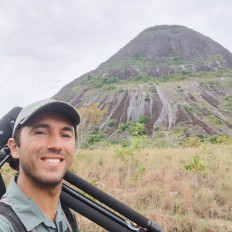Top species
- Chestnut Wood-Quail (Odontophorus hyperythrus)
- Cloud-forest Pygmy-Owl (Glaucidium nubicola)
- Yellow-breasted Antpitta (Grallaria flavotincta)
- Fulvous-dotted Treerunner (Margarornis stellatus)
- Club-winged Manakin (Machaeropterus deliciosus)
- Orange-breasted Fruiteater (Pipreola jucunda)
- Olivaceous Piha (Snowornis cryptolophus)
- Beautiful Jay (Cyanolyca pulchra)
- Black Solitaire (Entomodestes coracinus)
- Yellow-collared Chlorophonia (Chlorophonia flavirostris)
- Tanager Finch (Oreothraupis arremonops)
- Crested Ant-Tanager (Habia cristata)
- Black-and-gold Tanager (Bangsia melanochlamys)
- Gold-ringed Tanager (Bangsia aureocincta)
- Multicolored Tanager (Chlorochrysa nitidissima)
- Indigo Flowerpiercer (Diglossa indigotica)
List up to ca. 25 species that:
• have a limited distribution range and/or are rare on a global level
• are most sought-after by birdwatchers at this site
• and are relatively easy to see at this site (year-round or seasonally)
| Chestnut Wood-Quail (Odontophorus hyperythrus) | |
| Cloud-forest Pygmy-Owl (Glaucidium nubicola) | |
| Yellow-breasted Antpitta (Grallaria flavotincta) | |
| Fulvous-dotted Treerunner (Margarornis stellatus) | |
| Club-winged Manakin (Machaeropterus deliciosus) | |
| Orange-breasted Fruiteater (Pipreola jucunda) | |
| Olivaceous Piha (Snowornis cryptolophus) | |
| Beautiful Jay (Cyanolyca pulchra) | |
| Black Solitaire (Entomodestes coracinus) | |
| Yellow-collared Chlorophonia (Chlorophonia flavirostris) | |
| Tanager Finch (Oreothraupis arremonops) | |
| Crested Ant-Tanager (Habia cristata) | |
| Black-and-gold Tanager (Bangsia melanochlamys) | |
| Gold-ringed Tanager (Bangsia aureocincta) | |
| Multicolored Tanager (Chlorochrysa nitidissima) | |
| Indigo Flowerpiercer (Diglossa indigotica) |
Yellow-breasted Antpitta (Grallaria flavotincta) was added by Johnnier Arango (2021-08-24 22:50:28)
Yellow-collared Chlorophonia (Chlorophonia flavirostris) was added by Johnnier Arango (2021-08-24 22:49:54)
Cloud-forest Pygmy-Owl (Glaucidium nubicola) was added by Johnnier Arango (2021-08-24 22:49:39)
Club-winged Manakin (Machaeropterus deliciosus) was added by Johnnier Arango (2021-08-24 22:48:59)
Fulvous-dotted Treerunner (Margarornis stellatus) was added by Johnnier Arango (2021-08-24 22:48:46)
Crested Ant-Tanager (Habia cristata) was added by Johnnier Arango (2021-08-24 22:48:24)
Black Solitaire (Entomodestes coracinus) was added by Johnnier Arango (2021-08-24 22:48:10)
Orange-breasted Fruiteater (Pipreola jucunda) was added by Johnnier Arango (2021-08-24 22:47:59)
Black-and-gold Tanager (Bangsia melanochlamys) was added by Johnnier Arango (2021-08-24 22:47:42)
Olivaceous Piha (Snowornis cryptolophus) was added by Johnnier Arango (2021-08-24 22:47:25)
Chestnut Wood-Quail (Odontophorus hyperythrus) was added by Johnnier Arango (2021-08-24 22:47:11)
Indigo Flowerpiercer (Diglossa indigotica) was added by Johnnier Arango (2021-08-24 22:46:58)
Multicolored Tanager (Chlorochrysa nitidissima) was added by Johnnier Arango (2021-08-24 22:46:36)
Beautiful Jay (Cyanolyca pulchra) was added by Johnnier Arango (2021-08-24 22:46:18)
Tanager Finch (Oreothraupis arremonops) was added by Johnnier Arango (2021-08-24 22:46:02)
Gold-ringed Tanager (Bangsia aureocincta) was added by Johnnier Arango (2021-08-24 22:45:50)


